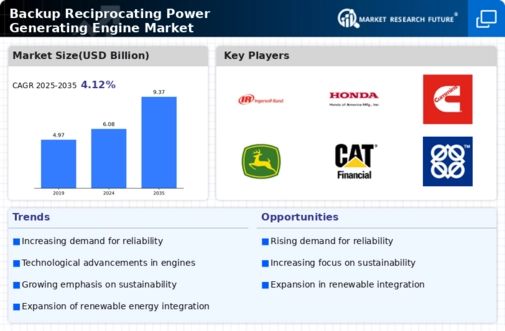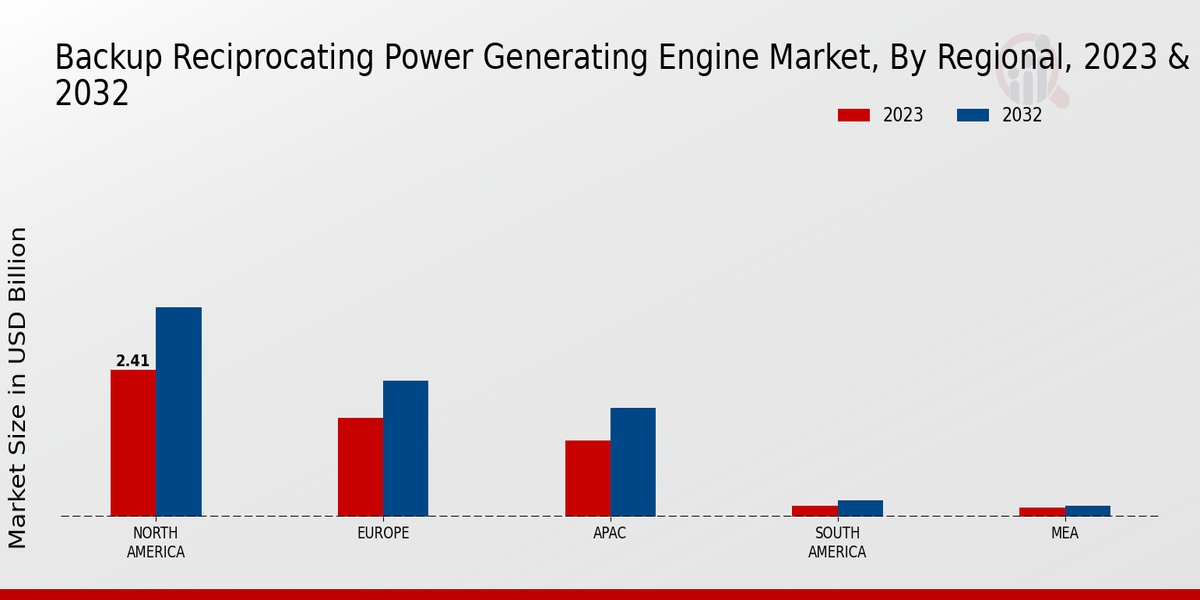Market Growth Projections
The Global Backup Reciprocating Power Generating Engine Market Industry is poised for substantial growth, with projections indicating a market value of 6.08 USD Billion in 2024 and an expected increase to 9.37 USD Billion by 2035. This growth trajectory suggests a compound annual growth rate (CAGR) of 4.01% from 2025 to 2035. The market dynamics are influenced by various factors, including technological advancements, increasing power outage frequency, and government regulations. These elements collectively contribute to a robust market outlook, indicating a promising future for the adoption of backup reciprocating power generating engines.
Increasing Frequency of Power Outages
The increasing frequency of power outages globally significantly influences the Global Backup Reciprocating Power Generating Engine Market Industry. Factors such as extreme weather events, aging infrastructure, and rising energy demands contribute to this trend. For instance, regions prone to hurricanes or heavy storms often experience prolonged outages, necessitating reliable backup solutions. Consequently, businesses and residential users are investing in backup power systems to mitigate the impact of outages. This growing awareness and need for resilience in power supply are likely to drive the market's growth, with a projected CAGR of 4.01% from 2025 to 2035.
Government Initiatives and Regulations
Government initiatives and regulations aimed at promoting energy security and sustainability are crucial drivers of the Global Backup Reciprocating Power Generating Engine Market Industry. Many governments are implementing policies that encourage the adoption of backup power systems, particularly in critical sectors. For instance, regulations mandating backup power for healthcare facilities and data centers are becoming more common. These initiatives not only enhance energy reliability but also support the transition to cleaner energy sources. As governments continue to prioritize energy resilience, the market is likely to benefit from increased adoption and investment in reciprocating engines.
Rising Demand for Reliable Power Supply
The Global Backup Reciprocating Power Generating Engine Market Industry experiences heightened demand for reliable power supply across various sectors. Industries such as healthcare, telecommunications, and data centers increasingly rely on backup power solutions to ensure uninterrupted operations. For instance, the healthcare sector requires consistent power to maintain life-saving equipment, while data centers depend on backup systems to prevent data loss. This trend is expected to drive the market's growth, with projections indicating a market value of 6.08 USD Billion in 2024. As organizations recognize the importance of backup power, investments in reciprocating engines are likely to increase.
Growing Industrialization and Urbanization
The rapid pace of industrialization and urbanization across the globe significantly impacts the Global Backup Reciprocating Power Generating Engine Market Industry. As urban areas expand and industries grow, the demand for reliable power sources intensifies. This trend is particularly evident in developing countries, where infrastructure development is accelerating. Industries such as manufacturing and construction require consistent power to maintain productivity and efficiency. As a result, investments in backup power solutions are expected to rise, further driving market growth. The combination of industrial expansion and urban development creates a favorable environment for the adoption of reciprocating engines.
Technological Advancements in Engine Efficiency
Technological advancements in engine efficiency play a pivotal role in shaping the Global Backup Reciprocating Power Generating Engine Market Industry. Innovations in engine design, fuel efficiency, and emissions reduction technologies contribute to enhanced performance and lower operational costs. For example, the introduction of advanced control systems allows for optimized fuel consumption, thereby reducing overall expenses for end-users. As these technologies continue to evolve, they are expected to attract more investments, further propelling the market. The anticipated growth trajectory suggests that the market could reach 9.37 USD Billion by 2035, reflecting the positive impact of these advancements.












